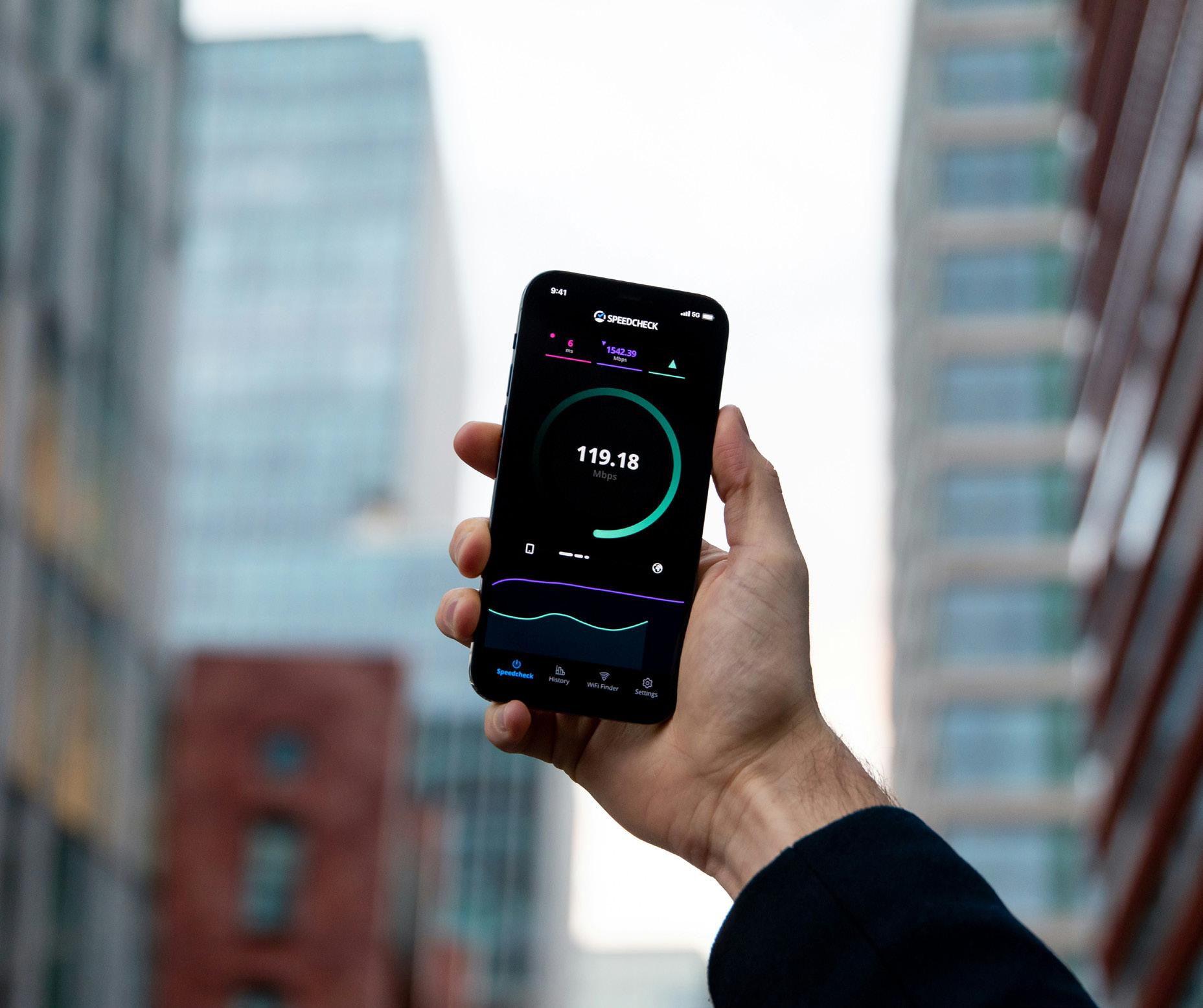
10 minute read
5G and Beyond: The Evolution of Connectivity
The fifth generation wireless technology, commonly known as 5G, is the latest version of cellular network technology. It has been appreciated for faster data speed, lower latency, greater reliability and increased capacity to connect more devices simultaneously compared to 4G LTE. Despite the appreciation it has been getting, it was previously surrounded with several myths and misconceptions. Do you remember when there were rumors about 5G saying it posed significant health risks like cancer due to its electromagnetic radiation? That was until WHO stepped in and assured the world that 5G operates within safe limits and does not pose any significant health risks. Also, do you remember the unfounded claims that circulated during the Covid019 pandemic saying 5G contributed to the spread of the virus? How can we forget the conspiracy theories suggesting that 5G was a tool used by governments to monitor our movements and communications? While it is true that advanced telecommunications technology can be used as potential surveillance tools, we should also be aware of the legal frameworks that exist regarding surveillance activities.
These myths and misconceptions only provide us with more reasons to address the lack of critical thinking, scientific literacy and fact checking. It is essential that we consider the environmental impact of any large scale technology deployment like 5G through research and regulations aimed at mitigating these impacts. The adverse environmental impacts can certainly be mitigated through careful planning and adherence to environmental standards. When we promote research and dissemination of accurate information, we can foster public trust and understand the value of emerging technologies like 5G. 5G has revolutionized numerous industries like telecommunications, entertainment, healthcare and transportation by enabling advancements like Augmented Reality (AR), Internet of Things (IoT) and so much more.
This article covers various topics like the current state of 5G and its applications, potential of 6G and beyond, and the impact of advanced connectivity like 5G and 6G on numerous industries. Let us begin by exploring the current state of 5G technology and its applications.
Telecom companies and governments have now set up 5G networks in both urban and rural areas to provide high speed connection to a broader population. This deployment has been done in various regions through installations of 5G infrastructures like antennas, small cells and other necessary equipment. Its speed reaches up to 10 GB per second, enabling ultra fast downloads, seamless streaming in HD quality and highly responsive gaming experience. Additionally, it plays a crucial role in the Internet of Things (IoT) ecosystem. This allows billions of interconnected devices to communicate and exchange data in real time. 5G has allowed facilitation of various IoT applications like smart sensors, remote monitoring systems and automated processes across industries like healthcare, agriculture, smart cities, transportation and manufacturing. This enhanced efficiency, productivity and convenience has been made possible due to low latency and high reliability provided by 5G.
The high speed and low latency connectivity of 5G has also been instrumental in delivering immersive AR and VR experiences. Whether it is gaming and entertainment or training simulations and virtual meetings, people can now rely on 5G for seamless streaming, enhanced user engagement and real- ism. 5G’s integration in edge computing also gives higher data transfer speeds between edge devices and centralized systems or cloud services. It also facilitates Mobile Edge Computing (MEC) by deploying edge servers and computing resources at the edge of the 5G network. This reduces latency and improves the overall user experience for applications like Virtual Reality (VR), Augmented Reality (AR) and gaming. In addition, 5G speed and reliability enables faster response times for latency sensitive applications like real time analytics and industrial automation. Various industries like healthcare and transportation can leverage 5G to transform their methods of operation. For example, healthcare can leverage 5G for telemedicine consultations and remote patient monitoring.
While 5G continues to evolve and drive restructuring in different sectors for a more connected and digitized future, there are still challenges that persist. Some of the challenges that require focus are cyber security, spectrum availability and geographical network coverage. Once these challenges are resolved, 5G adoption can be expanded globally.
Although 5G is still being deployed in many locations, the development of 6G promises us with more possibilities. Howev- er, its possibilities depend on factors like technological advancements, regulatory framework, spectrum availability, and industry investments. While we cannot precisely estimate the availability of the 6G network, we can envision the possibilities it can lead us to.
6G’s speed will no doubt surpass 5G’s speed, potentially reaching the range of terabytes per second. This ultra-high speed could enable us with seamless streaming of 8K and 16K resolution contents, not to mention, holographic videos as well. We may be able to download large files in an instant and be a part of immersive virtual reality experiences. WIth ultra-high speed and ultra-low latency, 6G technology is likely to provide users with near-instantaneous response. This feature is essential for applications like remote surgery, autonomous vehicles and industrial automation. When delays are reduced in data transmission, users across various industries can have more precise and responsive control systems.
The massive connectivity promised by 6G is crucial for the expansion of the Internet of Things (IoT) ecosystem. If billions of connected devices can communicate and exchange data, smart cities, smart homes and smart infrastructure can become even more intelligent and interconnected. This leads to improved efficiency, sustainability and quality of life. By integrating AI in 6G networks, network performance can be optimized to predict and prevent probable issues and personalize user experience. 6G networks can leverage Machine Learning (ML) and AI algorithms to adapt dynamically to changing conditions, efficiently allocate resources, and provide tailored services based on user preferences and behavior.
Moving beyond ultra-high speed and ultra-low latency, the 6G network can be expected to enable us with entirely new use cases and capabilities. This includes futuristic concepts like holographic communication, decentralized virtual worlds, brain-computer interfaces and immersive telepresence. All these promising potentials of 6G allows us to envision a breakthrough in industries like healthcare, education, manufacturing, logistics and environmental monitoring. While its full potential is yet to be realized, we need to support research and collaboration among academia, government stakeholders and industries for a future of wireless connectivity driven by innovation. Our individual roles in support, collaboration and investments will unblock novel possibilities that will transform the way we and our future generations will live, work and communicate.
As the role of 5G and 6G in various industries are infinite, I have chosen healthcare, manufacturing and smart cities specifically for this article. Let us dive into the profound impact that 5G and 6G technologies have made and will make in terms of innovation and efficiency in those three industries.
5G has revolutionized telemedicine and remote monitoring in the healthcare sector. Its speed and reliability has empowered healthcare professionals to deliver telemedicine services more effectively by facilitating remote consultations, diagnosis and treat- ment monitoring. This has eliminated the need for physical travel for patients in remote or underserved areas, making healthcare services more accessible. Advanced connectivity has also allowed indefectible transmission of large volumes of medical data. Healthcare providers can access high-resolution imaging and patient records which not only gives them real time data analytics but also aids in their decision making. This technology can be leveraged by healthcare professionals to enhance diagnosis, help personalized treatment plans and improve patient outcomes. The Internet of Medical Things (IoMT) requires robust connection in order to support a wide range of interconnected medical devices. These medical devices include wearable sensors, implantable devices and remote monitoring systems. 5G and 6G can allow secure and reliable communication between these devices, permitting continuous health monitoring, proactive medical intervention and early disease detection.


Advanced connectivity technologies have guided us to the fourth industri- al revolution, synonymously known as Industry 4.0. The integration of 5G and 6G technologies has the potential to revolutionize the manufacturing industry in several ways. Firstly, these advanced connectivity technologies are crucial in the transition to Industry 4.0 and the development of smart manufacturing facilities. By implementing real-time monitoring and control systems, manufacturers can optimize production processes and ensure efficient operations. Additionally, predictive maintenance can be enabled, minimizing downtime and enhancing overall efficiency. Another area where 5G and 6G can bring significant advancements is in robotics and automation. With high-speed and low-latency connectivity, collaborative robots (cobots) and autonomous machines can operate safely and efficiently in manufacturing environments. This advanced connectivity allows robots to communicate with each other and with centralized control systems in real-time, enabling the creation of flexible and adaptive production lines. Furthermore, enhanced connectivity provided by 5G and 6G enables greater visibility and transparency across the supply chain. From raw material sourcing to product delivery, manufacturers can leverage real-time data and analytics to optimize inventory management, streamline logistics operations, and respond more effectively to changing market demands. This increased visibility and optimization potential can lead to improved efficiency and cost savings throughout the supply chain.
The integration of 5G and 6G technologies has the potential to revolutionize smart cities by transforming urban infrastructure and services. These advanced connectivity technologies serve as the foundation for smart city initiatives, enabling the seamless interconnection of sensors, devices, and systems. This interconnected network allows for more efficient management of various aspects of urban life, such as smart lighting, traffic management, waste management, and energy distribution systems. By implementing 5G and 6G, cities can significantly improve sustainability and enhance the overall quality of life for their residents. In addition to transforming urban infrastructure, the deployment of 5G and 6G networks plays a crucial role in enhancing public safety and emergency response capabilities within smart cities. The high-speed and low-latency connectivity provided by these technologies enables real-time communication and data sharing among emergency responders and public safety agencies. This seamless flow of information enhances situational awareness, allowing for better coordination of emergency response efforts. Furthermore, smart city technologies powered by advanced connectivity contribute to improved disaster preparedness and resilience, ensuring that cities are better equipped to handle unforeseen emergencies. Advanced connectivity not only revolutionizes infrastructure and public safety but also fosters greater citizen engagement and participation in smart city initiatives. Through digital platforms and services, citizens can access real-time information about city services, providing them with a deeper understanding of their urban environment. This connectivity also enables citizens to provide feedback and input, actively participating in decision-making processes that shape their cities. By promoting inclusivity and responsiveness in urban governance, advanced connectivity empowers citizens to actively contribute to the development and improvement of their communities, ultimately leading to more vibrant and sustainable smart cities.

In conclusion, the evolution of connectivity from 5G to the promising horizon of 6G marks a pivotal moment in our technological advancement. As we reflect on the journey from debunking myths surrounding 5G to envisioning the boundless possibilities of 6G, it becomes evident that our collective efforts in research, regulation, and education have been instrumental in shaping the narrative of advanced telecommunications. The deployment of 5G networks has already begun to revolutionize industries such as telecommunications, healthcare, manufacturing, and smart cities. Its high-speed, low-latency connectivity has empowered innovations like telemedicine, smart manufacturing, and efficient urban infrastructure man- agement. Moreover, by addressing challenges such as cybersecurity and spectrum availability, we pave the way for broader adoption and global expansion of 5G technology.
Looking ahead, the advent of 6G promises even greater advancements, with speeds potentially reaching terabytes per second and opening doors to transformative applications like holographic communication and decentralized virtual worlds. The integration of AI and machine learning in 6G networks holds the key to optimizing performance and personalizing user experiences across various sectors. As we embrace the opportunities presented by 5G and look towards the horizon of 6G, it is imperative that we remain committed to fostering innovation, collaboration, and responsible deployment of advanced connectivity technologies. By doing so, we can unlock the full potential of wireless connectivity to drive economic growth, enhance quality of life, and shape a more connected and inclusive future for generations to come.


